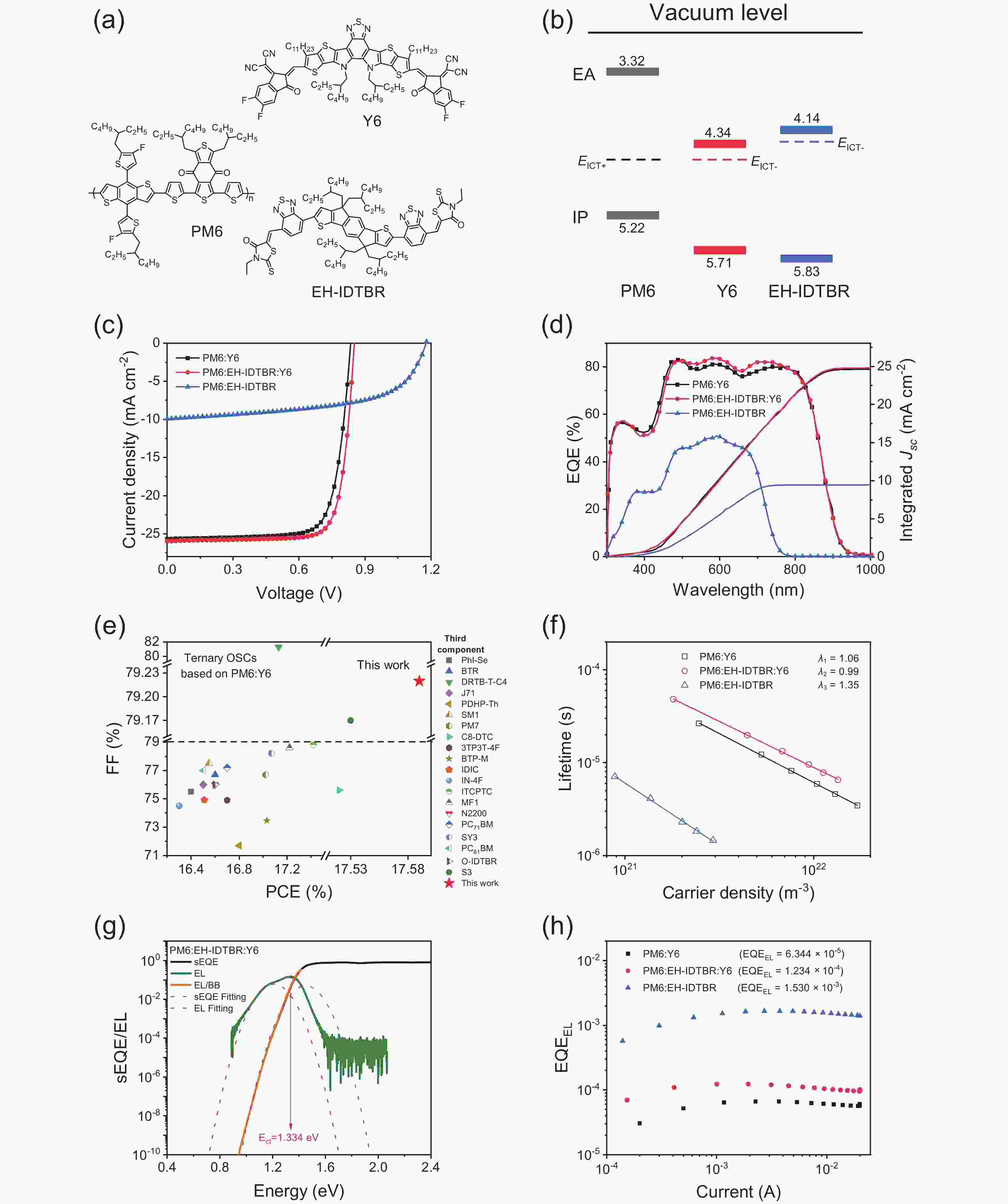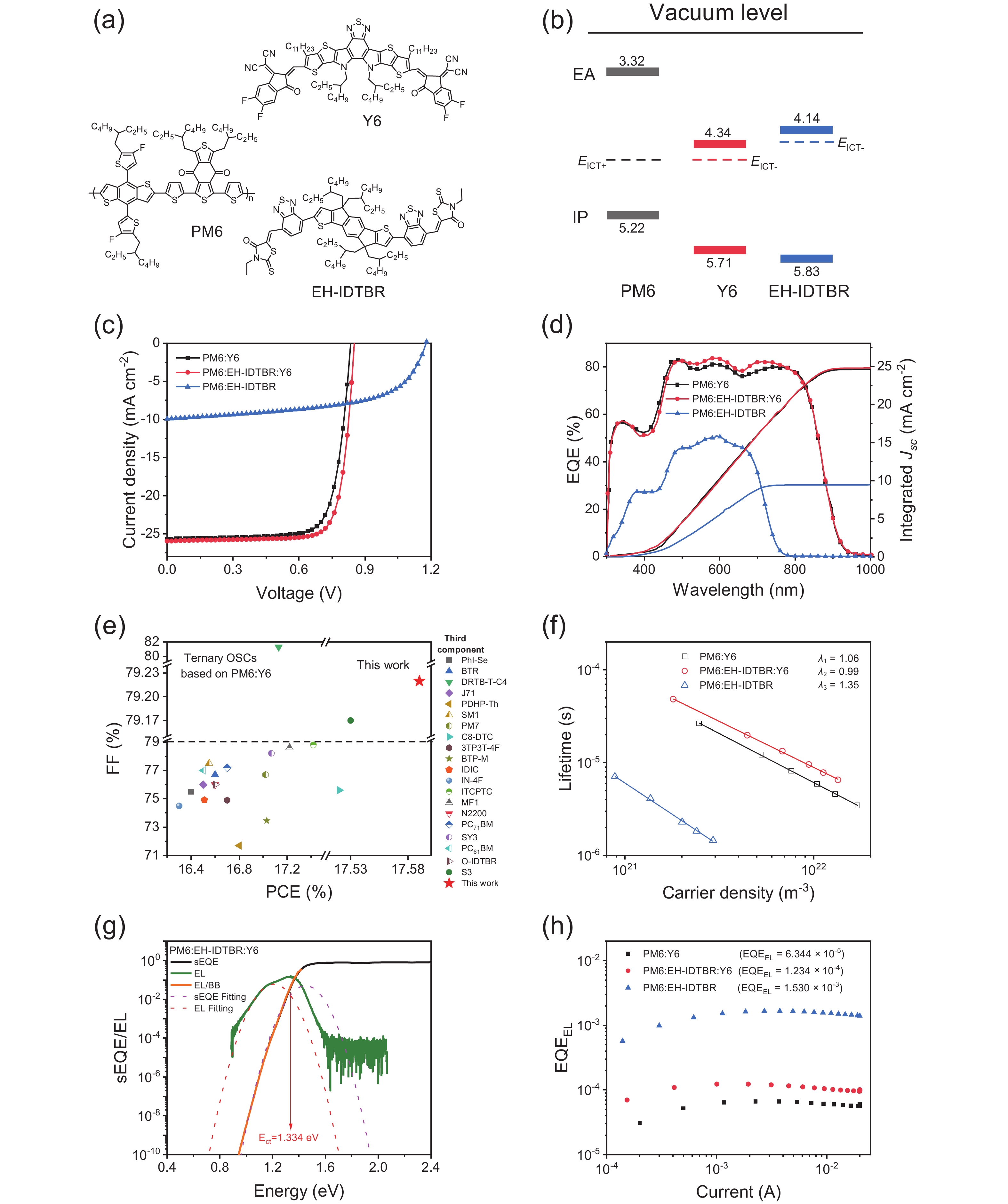| Citation: |
Danqin Li, Yihan Zeng, Zeng Chen, Shifeng Leng, Zuo Xiao, Qifan Xue, Tianyu Hao, Meng Lv, Hongbo Wu, Lina Lin, Jianming Yang, Zaifei Ma, Jinquan Chen, Rong Huang, Feng Liu, Haiming Zhu, Xianjie Liu, Liming Ding, Mats Fahlman, Qinye Bao. Investigating the reason for high FF from ternary organic solar cells[J]. Journal of Semiconductors, 2021, 42(9): 090501. doi: 10.1088/1674-4926/42/9/090501
D Q Li, Y H Zeng, Z Chen, S F Leng, Z Xiao, Q F Xue, T Y Hao, M Lv, H B Wu, L N Lin, J M Yang, Z F Ma, J Q Chen, R Huang, F Liu, H M Zhu, X J Liu, L M Ding, M Fahlman, Q Y Bao, Investigating the reason for high FF from ternary organic solar cells[J]. J. Semicond., 2021, 42(9): 090501. doi: 10.1088/1674-4926/42/9/090501.
Export: BibTex EndNote
|
Investigating the reason for high FF from ternary organic solar cells
doi: 10.1088/1674-4926/42/9/090501
More Information-
References
[1] Bao Q, Liu X, Braun S, et al. Intermixing effect on electronic structures of TQ1:PC71BM bulk heterojunction in organic photovoltaics. Sol RRL, 2017, 1, 1700142 doi: 10.1002/solr.201700142[2] Li S, Ye L, Zhao W, et al. A wide band gap polymer with a deep highest occupied molecular orbital level enables 14.2% efficiency in polymer solar cells. J Am Chem Soc, 2018, 140, 7159 doi: 10.1021/jacs.8b02695[3] Cui Y, Yao H, Zhang J, et al. Over 16% efficiency organic photovoltaic cells enabled by a chlorinated acceptor with increased open-circuit voltages. Nat Commun, 2019, 10, 2515 doi: 10.1038/s41467-019-10351-5[4] Liu Q, Jiang Y, Jin K, et al. 18% efficiency organic solar cells. Sci Bull, 2020, 65, 272 doi: 10.1016/j.scib.2020.01.001[5] Zhang M, Zhu L, Zhou G, et al. Single-layered organic photovoltaics with double cascading charge transport pathways: 18% efficiencies. Nat Commun, 2021, 12, 1 doi: 10.1038/s41467-020-20314-w[6] Zhan L, Li S, Xia X, et al. Layer-by-layer processed ternary organic photovoltaics with efficiency over 18. Adv Mater, 2021, 33, 2007231 doi: 10.1002/adma.202007231[7] Qin J, Zhang L, Zuo C, et al. A chlorinated copolymer donor demonstrates a 18.13% power conversion efficiency. J Semicond, 2021, 42, 010501 doi: 10.1088/1674-4926/42/1/010501[8] Jin K, Xiao Z, Ding L. D18, an eximious solar polymer!. J Semicond, 2021, 42, 010502 doi: 10.1088/1674-4926/42/1/010502[9] Xie Y, Wang W, Huang W, et al. Assessing the energy offset at the electron donor/acceptor interface in organic solar cells through radiative efficiency measurements. Energy Environ Sci, 2019, 12, 3556 doi: 10.1039/C9EE02939G[10] Sun R, Wu Q, Guo J, et al. A layer-by-layer architecture for printable organic solar cells overcoming the scaling lag of module efficiency. Joule, 2020, 4, 1 doi: 10.1016/j.joule.2019.10.011[11] Yuan J, Zhang Y, Zhou L, et al. Single-junction organic solar cell with over 15% efficiency using fused-ring acceptor with electron-deficient core. Joule, 2019, 3, 1140 doi: 10.1016/j.joule.2019.01.004[12] Perdigon-Toro L, Zhang H, Markina A, et al. Barrierless free charge generation in the high-performance PM6:Y6 bulk heterojunction non-fullerene solar cell. Adv Mater, 2020, 32, 1906763 doi: 10.1002/adma.201906763[13] Liu S, You P, Li J, et al. Enhanced efficiency of polymer solar cells by adding a high-mobility conjugated polymer. Energy Environ Sci, 2015, 8, 1463 doi: 10.1039/C5EE00090D[14] Du X, Yuan Y, Zhou L, et al. Delayed fluorescence emitter enables near 17% efficiency ternary organic solar cells with enhanced storage stability and reduced recombination energy loss. Adv Funct Mater, 2020, 30, 1909837 doi: 10.1002/adfm.201909837[15] Yan T, Ge J, Lei T, et al. 16.55% efficiency ternary organic solar cells enabled by incorporating a small molecular donor. J Mater Chem A, 2019, 7, 25894 doi: 10.1039/C9TA10145D[16] Bao Q, Sandberg O, Dagnelund D, et al. Trap-assisted recombination via integer charge transfer states in organic bulk heterojunction photovoltaics. Adv Funct Mater, 2014, 24, 6309 doi: 10.1002/adfm.201401513[17] Bao Q, Liu X, Wang E, et al. Regular energetics at conjugated electrolyte/electrode modifier for organic electronics and their implications on design rules. Adv Mater Interfaces, 2015, 2, 1500204 doi: 10.1002/admi.201500204[18] Li D, Zhu L, Liu X, et al. Enhanced and balanced charge transport boosting ternary solar cells over 17% efficiency. Adv Mater, 2020, 32, 2002344 doi: 10.1002/adma.202002344[19] Li Q, Sun Y, Xue X, et al. Insights into charge separation and transport in ternary polymer solar cells. ACS Appl Mat Interfaces, 2019, 11, 3299 doi: 10.1021/acsami.8b18240[20] Zhang L, Xu X, Lin B, et al. Achieving balanced crystallinity of donor and acceptor by combining blade-coating and ternary strategies in organic solar cells. Adv Mater, 2018, 30, 1805041 doi: 10.1002/adma.201805041[21] Liu T, Ma R, Luo Z, et al. Concurrent improvement in Jsc and Voc in high-efficiency ternary organic solar cells enabled by a red-absorbing small-molecule acceptor with a high LUMO level. Energy Environ Sci, 2020, 13, 2115 doi: 10.1039/D0EE00662A[22] Gasparini N, Jiao X, Heumueller T, et al. Designing ternary blend bulk heterojunction solar cells with reduced carrier recombination and a fill factor of 77%. Nat Energy, 2016, 1, 1 doi: 10.1038/NENERGY.2016.118[23] Nian L, Kan Y, Wang H, et al. Ternary non-fullerene polymer solar cells with 13.51% efficiency and a record-high fill factor of 78.13%. Energy Environ Sci, 2018, 11, 3392 doi: 10.1039/C8EE01564C[24] Xie G, Zhang Z, Su Z, et al. 16.5% efficiency ternary organic photovoltaics with two polymer donors by optimizing molecular arrangement and phase separation. Nano Energy, 2020, 69, 104447 doi: 10.1016/j.nanoen.2020.104447[25] Rosenthal K D, Hughes M P, Luginbuhl B R, et al. Quantifying and understanding voltage losses due to nonradiative recombination in bulk heterojunction organic solar cells with low energetic offsets. Adv Energy Mater, 2019, 9, 1901077 doi: 10.1002/aenm.201901077[26] Ran N A, Roland S, Love J A, et al. Impact of interfacial molecular orientation on radiative recombination and charge generation efficiency. Nat Commun, 2017, 8, 79 doi: 10.1038/s41467-017-00107-4[27] Karki A, Vollbrecht J, Dixon A L, et al. Understanding the high performance of over 15% efficiency in single-junction bulk heterojunction organic solar cells. Adv Mater, 2019, 31, 1903868 doi: 10.1002/adma.201903868[28] Karki A, Vollbrecht J, Gillett A J, et al. Unifying charge generation, recombination, and extraction in low-offset non-fullerene acceptor organic solar cells. Adv Energy Mater, 2020, 10, 2001203 doi: 10.1002/aenm.202001203 -
Supplements
 21070011suppl.pdf
21070011suppl.pdf

-
Proportional views






 DownLoad:
DownLoad:














